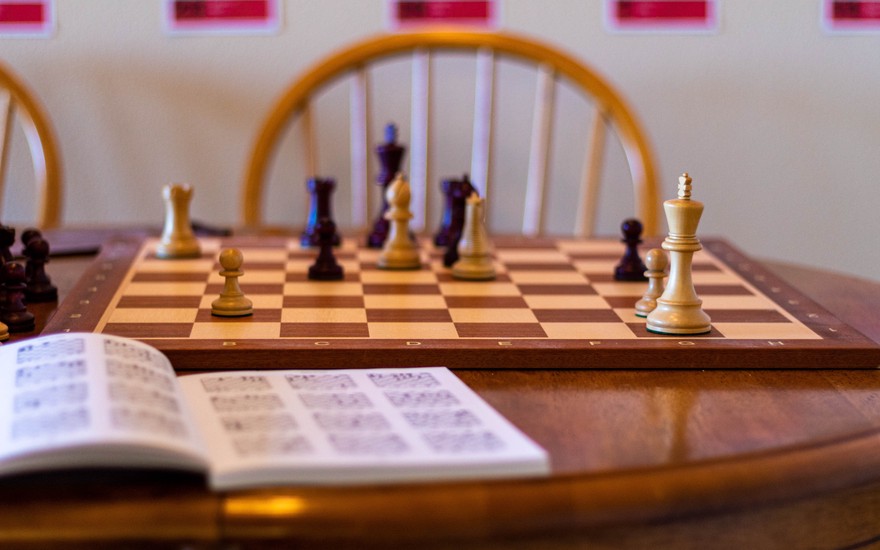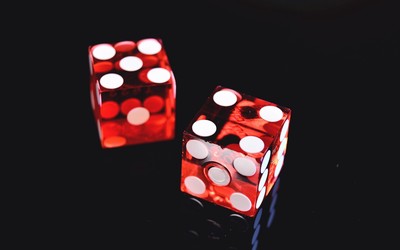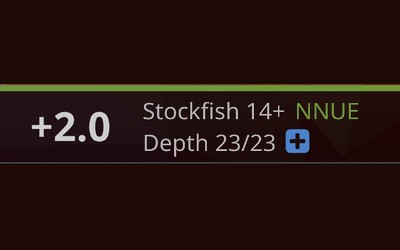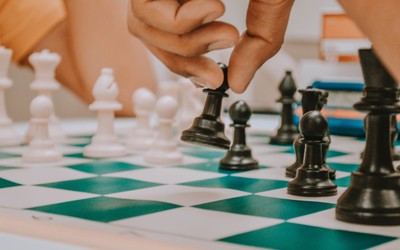
Photo by Sean Mullowney on Unsplash
How We Play and Learn Chess
Insights from my recent reading on chess, high performance, and the philosophy of gaming.Over the last few months I’ve been reading up on the nature of games and the psychology behind them. It’s led me to some counter-intuitive ideas about chess playing and learning and what might be the best way to progress as a chess player.
I’ve read three books, only one of which was specifically on chess.
Move First, Think Later: Sense and Nonsense in Improving Your Chess by IM Willy Hendriks looks at chess playing and learning from the point of view of cognitive science.
The Inner Game of Tennis: The Classic Guide to the Mental Side of Peak Performance by W. Timothy Gallwey looks at lessons from tennis to draw out your best possible performance. It seems like an odd choice, but I had seen it recommended in a chess forum discussion, so decided to give it a read.
Finally, Games: Agency as Art by C. Thi Nguyen is a popular philosophy book on the nature of games and why we play them.
Who plays chess?
I could write a really long article on each of these books, but I think you would benefit more from just reading them yourself. Here, I’m going to discuss a few of the key things I learned from them and what I think they mean.
The thing that really blew me away is this: YOU don’t actually play chess. There’s a part of you that does, but it’s not the conscious part, which is the part that you think of as you. In The Inner Game, this part of you is referred to as Self 2. In Move First, Think Later, this part of you is referred to as your chess module.
Much of the Inner Game is focussed on techniques to keep Self 1, the conscious, goal-oriented part of you—literally, the you part of you—from interfering with Self 2, the part of you that actually controls your muscles and moves you around the tennis court. You don’t walk from the couch to the kitchen by consciously deciding which leg muscles to tense at which moment. The same is true when you are playing tennis. Consciously trying to control Self 2 will just tighten up your body and make your performance worse.
Move First, Think Later talked about this part of your brain, the part that makes the move—not the "you" part that afterwards realizes you just hung your queen—as the chess module of your brain. It’s a pattern matching engine.
I read Move First, Think Later before The Inner Game and, at first, couldn’t figure out what Self 2 had to do with the chess module. Self 2 in tennis is what controls your muscles in that half second you have to figure out where the ball is going and return it to your opponent. What did that have to do with chess calculation? Then it occurred to me.
Your chess module will only feed your conscious mind with patterns it recognizes. Over and over again in the book, Willy Hendriks says that when you look at a chess position, you have no choice but to start seeing lines. Except, he’s a master and I’m a novice and I looked at some of the positions in the book and drew a complete blank. There seemed to be no good moves and yet, it was checkmate for black in 4 moves or something similar. My chess module is just not that highly developed yet.
All this agrees with what we know about grandmasters and novices. There is research quoted in Move First, Think Later that shows that grandmasters and novices consider about the same number of lines before making a move; it’s just that the lines that the GMs consider are actually good. There is research mentioned in a recent blog post showing that chess grandmasters learn around 300,000 separate pieces of information. They are training their chess modules. You don’t hear them talk about those pieces of information; instead, they talk about some moves feeling more natural than others.
Positions and patterns
As a chess player, you are probably well aware about the complexity of the game. There are 10^40 legal positions reachable from the initial board setup. That's a 1 followed by 40 zeros. When you put your games through an opening explorer on Chess.com or Lichess, you inevitably get to a position where there’s nothing in the database. Why is that? It’s because there are so many possible games that every sufficiently long game you play is unique.
Let’s call the current set up of the entire board the position. Let’s call any move or combination of moves that is allowed in the current position a pattern. The move or moves don't have to make sense; they just have to be legal.
There can be many patterns that apply to any given position. Some of these patterns are so common that we have names for them like the Fried Liver Attack, Greek Gift, queen sac, back-rank mate, smothered mate, or Philidor position. We develop heuristics, rules of thumb, to remember to use certain patterns or avoid others, like GM Ben Finegold’s maxim: “Never play f3!”
The problem is that only certain patterns apply to specific positions and you are guaranteed to get to a position that is new to you fairly quickly in a game. Back-rank mate may not be possible because the square you need to get to is covered by an opponent’s piece. Or playing f3 may be exactly what you need to do. Even Ben Finegold has played f3.
Why didn’t I see that?
A lot of the pattern recognition that your chess module is doing is figuring out which patterns apply to the current position. If the computer or your coach points out a pattern that you didn’t see, it’s not because you missed it, it’s because your chess module didn’t perceive it and serve it up to you during the game. Yes, you can use checklists or go over everything again, but eventually you have to make a move. Time trouble is one of the chess equivalents of tightening up in tennis.
I know that it is frustrating and counterintuitive for you not to see something that seems obvious after it is pointed out or even immediately after you make the move. Unlike poker, chess is a perfect-information game. You and your opponent know everything there is to know about the current state of the game. There is nothing hidden, so why do we miss things? Your chess module just misses it.
It could be that your chess module doesn't have the pattern to serve up to you, or it could have the pattern but there are other things going on. There’s a context in which you play that is largely absent when you are doing puzzles or endgame studies. You just made a move or your opponent has. You have ideas of what you want to happen and so do they. You may get halfway through a sequence you’d planned out only to realize that it loses you a piece. Or maybe you get all the way through the sequence and have one less piece than you thought you would. You see the board, but you also see plans and threats and opportunities. You can be under time pressure. There are a host of external factors that can affect your game. You can be hungry, tired, distracted, burnt out, tilting, or just not able to concentrate that day. The pattern may be there in your brain, but it doesn’t always show up when you need it. Even Levon Aronian has blundered mate in 1.
How to improve
The bad news from Move First, Think Later is that there is no shortcut. There’s no program or system that will get you all the way to World Champion or master or beer league champion—whatever your goal is—by following a simple set of rules when you play. The author spends a considerable amount of the book calling out chess books and coaches for selling what he sees as get-good-quick schemes. The real work is in training your chess module to recognize patterns. Grandmasters didn’t start with 300,000 pieces of information; they built it up over time.
The good news is that just about anything you do will improve your chess as long as it focuses on patterns. Remember that the definition of patterns I’m using here is really broad. It can be openings, endgames, tactics, strategic plans, or anything that makes you understand a certain set of moves and if they apply to the current position. The more patterns you see, the more likely you are to perceive them in the positions you get in your games.
And it’s in your games that you’ll find the richest source of learning because you’ve already spent considerable time thinking about what patterns apply to the positions you got there and you’ve gotten direct feedback from your opponent about whether those patterns were good or not. The longer the game, the more rich the thinking you’ve put into it and the more likely that you’ll learn from your mistakes if you analyze your games afterwards.
Because your own games can be so rich a learning tool, I’ve chosen to join Aimchess and the new ChessDojo Training Program. Aimchess uses your games to generate much of its training material for your personalized training plan. The ChessDojo Training Program focusses your play on classical-length games and requires you to do in-depth analysis afterwards. You do this in a cohort that is around your rating range, which creates both a sense of community and a critical mass that may be hard to come by on your own. There is other training involved in both programs, but the core of each is focussed on your own play.
Types of players
The third book I read was Games: Agency as Art. It’s essentially an academic book on the philosophy of games written for a popular audience. I would recommend reading it if you like to think about things like games from a theoretical point of view.
I read it because I like theory, but also because I’ve had a problem with anxiety in my games. I get anxious playing. It’s not rating anxiety. I could sum it up as fear of blundering on pretty much every move. It seriously limited the number of games I played in my first year back.
Games distinguishes between two types of players, and then spends a lot of time proving that the second type of player actually exists.
The first type of player is the type that all of us are familiar with, the achievement player. The goal of the achievement player is to win. If they don’t win, it’s bad. Super GMs are achievement players because they have to be. They are there for the win. The only reason they get invited to the big events is because they win. If they start losing, they don’t get the invites anymore and fall off of everyone’s radar.
The second type of player is the striving player. They want to win because that’s the point of the game, but that’s not their main goal for playing. If you play a game of cards with your family after a holiday meal, you are playing the role of a striving player. You’d like to win because that’s the goal of the game, but you are really just there to play the game. The outcome is secondary.
Part of my anxiety was my perception that my random opponent from the pool was an achievement player, although I didn’t know about the concept until recently. Here was someone who just wanted to win, the quicker, the better. For someone like me who was just trying to learn, it could be really stressful to perceive your opponent in that way, even though you have no idea what they are actually thinking. Except sometimes you do know exactly what they are thinking, and that’s why I have chat turned off on Chess.com.
There is special type of striving player and it’s what I am and what I frequently encounter in the Chesspunks, Aimchess, and ChessDojo communities: the aesthetic striving player. It’s not enough to play the game; you do it because of the aesthetic quality of the struggle that the game involves. In other words, you play the game because you really enjoy it. Many Super GMs also fall into this category. They are professionals, so they have to be achievement players, but they also genuinely love the game. If you’ve ever seen a stream of Magnus playing chess on his phone in a hot tub, you realize he's not just in it for the Ws.
The games I’ve enjoyed the most are the ones where I know that the other person is as interested in the intricacies of the positions and of the decisions being made in the game as I am. That’s true even if I lose. Part of the cure for my anxiety has been playing others who are adult improvers and just genuinely nice people.
You want your opponents to play well
The other part of the cure for my anxiety comes from The Inner Game, although I think Games makes a similar point. In many of my chess games, I would get into a position where I suddenly realized that my opponent had a move that was very powerful and I had no good response. I would start to worry that they would make that move and would get a rush of adrenaline as a result.
In The Inner Game, the author has the same problem during a tournament. He realizes that his opponent will have an advantage if they return his volley in a particular way. What the author eventually concludes is that he always wants his opponent to find the best shot. It’s a test of his skill to respond. If he isn’t up to it this time then he will make sure that he is the next time they meet.
In fact, I think that’s part of the meaning behind the title of Move First, Think Later. Yes, you need to calculate your move, but you can only see what your chess module shows you, so, after a reasonable amount of time, you might as well pick the move that seems the best to you. Later, after the game, you’ll have a chance to think about what happened and find alternatives that you didn't see or couldn't have seen during the game. Maybe it will stick with you and you won't make the same mistake again. That’s how you learn. That's how you improve.
Photo by Sean Mullowney on Unsplash




